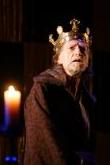SEARCH CurtainUp
REVIEWS
FEATURES
NEWS
Etcetera and
Short Term Listings
LISTINGS
Broadway
Off-Broadway
BOOKS and CDs
OTHER PLACES
Berkshires
London
LA/San Diego
DC
Philadelphia
Elsewhere
QUOTES
On TKTS
LETTERS TO EDITOR
FILM
LINKS
MISCELLANEOUS
Free Updates
Masthead
NYC Weather
 London Review
London Review
Henry IV Parts One and Two
by Lizzie Loveridge
|
O God, that one might read the book of fate, / And see the revolution of the times
--- Henry IV |

David Bradley as Henry IV
(Photo: Catherine Ashmore) |
The opening scenes to both parts of Henry IV are the most moving I remember seeing. In the first, the monarch, David Bradley surveys a war torn country, unmistakably England (no allusions to Iraq here), a country racked by civil war, women sobbing, sensitive music playing as the king walks down the steeply raked wooden ramp that forms the stage. Hytner's theme is one of order and anarchy and the price we pay for social order.
I do not remember such emphasis being placed on Hal's early speech along the line of the prodigal being made more welcome than the well behaved son who has stayed at home. As such he decides to gain a wild reputation so that his father may love him more as a reformed character. This self conscious decision alters the relationship between Falstaff and Hal. They never seem to bond as playmates, we are always conscious that Hal is using Falstaff and we have no doubt that in the final closing scene Falstaff will be rejected by the prince. Hytner's Henry IV is more about the relationship between father and son rather between surrogate father and Hal.
David Bradley is very potently cast as the morose but powerful Henry IV, judgmental about his eldest son, always comparing Hal unfavourably with the valiant Hotspur. It's an energetic and passionate performance from the magnificent David Harewood.
Michael Gambon by contrast is a Falstaff muzzled by Hytner, "blasted with antiquity", he is doddery and failing in health and not even allowed the famous Gambon vocal register lest we like him too much. After the battle of Shrewsbury, Falstaff is seen as a squalid figure picking the pockets of the battle dead. In Falstaff's scene with Doll Tearsheet (Eve Myles) there is more to cry about than laugh at but it's a long wait to achieve poignancy as we are reminded that "desire outlives performance."
Matthew MacFadyen, wearing jeans in this play's costume design which ranges from 1400 to 2000, struggles for his father's approval. He is likeable, a son whose father is harshest to him. An immensely comic touch is his arrival at the start of the second part when he literally rolls into the middle of a solemn service attended by his father in a scene dominated by a larger than life size crucifixion statue. Hal groans and covers his face with the chagrin of a delinquent about to be reprimanded yet again. The highpoint of the play is Henry IV's deathbed reconciliation with his son.
Unusually, the Justice Shallow part is outstanding, a very welcome diversion with veteran actor John Wood on top comedic form ably supported by Adrian Scarborough as Justice Silence. These two elderly justices are brilliant scene stealers. The biggest laugh of the evening is when Shallow greets a debilitated, faltering Sir John by telling him., "You look well!" The rejection of Falstaff seems less cruel of Hal in this production because it is a quotient of the intensity of their once friendship.
Henry IV's reign is blighted by the deposition and murder of the rightful king, Richard II. No matter that Richard was a despot, he was God's anointed monarch, and the disorder of Henry IV's mental state is reflected in the disorder of the country as Richard II's step brothers rebel against him. The "Uneasy lies the head that wears the crown" speech reminds of the burden Henry IV carries. Hytner's production brings out the suffering of England caught up in civil wars with sensitive use of music avoiding cliché.
Hytner's Henry IV does not quite live up to expectations but high expectation is a dangerous indicator. Like a recipe which seems to have many mouth watering ingredients, in the combining, the sum total is not as delicious as it should have been.
For a review of another two-part Henry IV at New York's Lincoln Center, as well as links to the numerous Shakespeare plays reviewed at CurtainUp, see our Shakespeare Quotation Page
| Henry IV Parts One and Two
Written by William Shakespeare Directed by Nicholas Hytner Starring: Michael Gambon, Matthew MacFadyen, David Bradley, David Harewood, John Wood With: Samuel Roukin, Thomas Arnold, Rupert Ward-Lewis, Robert Blythe, Tom Marshall, Elliot Levey, Iaon Mitchell, Jeffery Kissoon, John Carlisle, Penelope McGhie, Naomi Frederick, Rupert Ward-Lewis, Roert Lister, Harry Peacock, Andrew Westfield, Ian Gelder, Danny Worters, Susan Brown, Roger Sloman, Adrian Scarborough, Eve Myles, Alistair Petrie, Daren Hart, John Wood, Michelle Dockery Design: Mark Thompson Lighting: Neil Austin Sound: Paul Groothuis Music: Max Ringham, Ben Ringham and Andrew Rutland Fight Director: Terry King Running time: Each part around three hours with one interval Box Office: 0208 452 3000 Booking to 31st August 2005. Many seats £10 as part of the Travelex Season. Reviewed by Lizzie Loveridge based on 4th May performance at the Olivier Theatre, Royal National Theatre, South Bank, London SE1 (Rail/Tube: Waterloo) |


Mendes at the Donmar
Our Review

Peter Ackroyd's History of London: The Biography

London Sketchbook

Retold by Tina Packer of Shakespeare & Co. Click image to buy.
Our Review

6, 500 Comparative Phrases including 800 Shakespearean Metaphors by CurtainUp's editor.
Click image to buy.
Go here for details and larger image.
